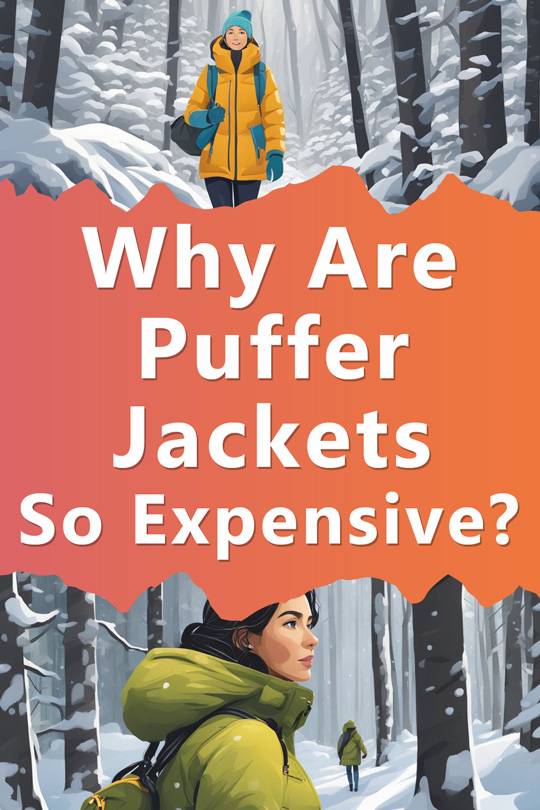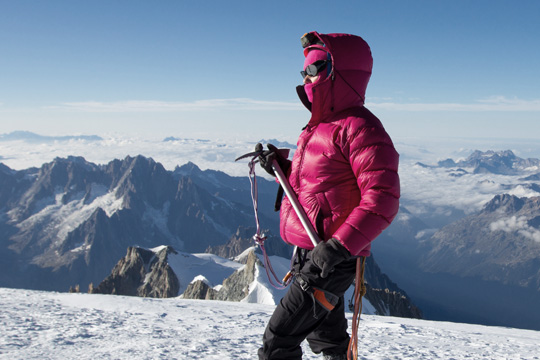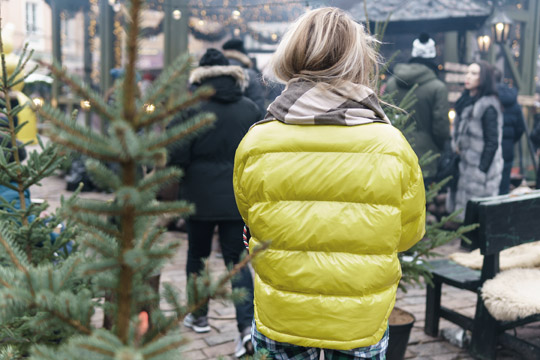
Puffer jackets, known for their distinctive style and warmth, have become a staple in winter fashion. However, you may have noticed that they often come with a hefty price tag.
The reasons for their high cost are many, beginning with the materials used to produce them.
Puffer jackets are typically filled with either synthetic fibers or down feathers, which are prized for their exceptional insulating properties. Down, especially, is a premium fill material harvested from the undercoating of ducks or geese, offering an unmatched warmth-to-weight ratio which adds to the cost.
But there are many other reasons that we’ll examine below.
The combination of these reasons culminates in the expensive price tag attached to many puffer jackets you see in stores today.
1. Why Are Puffer Jackets so Expensive?
Puffer jackets are expensive due to their high-quality materials and complex construction.
The premium fill materials, such as down feathers, offer exceptional warmth-to-weight ratios but are costly, especially when ethically sourced.
The intricate quilting patterns that characterize puffer jackets are not only stylish but functional, designed to retain heat and require precise, labor-intensive manufacturing processes.
Additionally, many puffer jackets incorporate advanced technologies like water-resistant coatings and breathable membranes, which enhance performance in harsh conditions but also add to the cost.
Lastly, brand reputation and marketing contribute to the higher prices, as many puffer jackets are associated with luxury and high-end outdoor labels, for example, Moncler, adding perceived value to the product.
Must read: 10 Best Expensive and Luxury Winter Jacket Brands
2. Historical Evolution of Puffer Jackets
The puffer jacket has undergone significant evolutionary changes since its inception, marked by design milestones and cultural impact that have cemented its status in fashion history.

Design Milestones
The puffer jacket’s ancestry can be traced back to the 1930s, when George Finch, an Australian chemist and mountaineer, created a version for his climbing expeditions. Finch’s innovative use of eiderdown and a silk shell to combat cold conditions marked a pivotal point in early puffer jacket design.
In 1940, Eddie Bauer received the first patent for a down jacket, known as the Skyliner, which enhanced the design with quilted layers for better heat retention.
Following these early versions, Charles James, a renowned couturier, played a pivotal role when in 1938 he created a sculptured silhouette for the puffer, paving the way for its entry into high fashion.
Decades later, in 1973, fashion designer Norma Kamali took inspiration from sleeping bags to create the iconic ‘sleeping bag coat’, an item that blurred the lines between practical outerwear and high fashion.
The transformation of the puffer jacket continued with iconic fashion houses like Balenciaga integrating the puffer into luxury fashion in the 2010s, reflecting a blend of aesthetics, technology, and design innovation.
Cultural Impact
The puffer jacket transcended its origins and became a staple in streetwear culture. Throughout the late 20th century into the 21st, its adoption by rappers and high-profile celebrities has helped elevate the puffer’s status as a symbol of power and style.
Prada’s reinterpretation of the puffer as a luxury item in the late 1990s and early 2000s further cemented the garment’s desirability and cultural significance.
This transformation indicates the puffer jacket’s versatility and ability to resonate with various groups, from outdoor enthusiasts to fashion-forward audiences and influential figures. It stands today not just as a product of utilitarian design but as a statement piece within global fashion culture.
Don’t miss: 7 Best Italian Down Jacket Brands for Winter
3. Material and Construction
Puffer jackets are the sum of their parts, where the quality and complexity of materials and the finesse of construction contribute significantly to their cost.
Quality of Down and Synthetic Fill
The warmth of your puffer jacket hinges on the fill quality; down is the premium choice, typically sourced from duck or goose. Down’s loft and the fill power indicate its warmth-to-weight ratio, with higher fill power showing better insulation.
Goose down usually offers higher fill power than duck down, making it more expensive. Manufacturers adhere to standards like the Responsible Down Standard (RDS) or Global Traceable Down Standard (GTDS) ensuring ethical sourcing, which can raise the cost.
Alternatively, synthetic fill, often made from recycled plastic, is less expensive but also less efficient in warmth for weight, and its performance can degrade faster over time than down.
Outer Materials and Resilience
Your jacket’s resistance to the elements relies on the outer materials. Nylon and polyester are standard for their durability and light weight. Finishes such as water-resistant or waterproof coatings add protection and value.
For extreme conditions, fabrics like GORE-TEX, which is both waterproof and breathable, are used, contributing to a higher price due to their technological sophistication and brand reputation. Products with these advanced materials promise longevity, making them a costlier investment.
Innovations in Insulation
Cutting-edge technologies in insulation directly affect puffer jacket prices. Innovations aimed at achieving the most effective thermal regulation without bulk typically involve complex manufacturing processes.
Jackets featuring materials that are simultaneously insulating and water-repellent add to costs due to the dual functionality. As the industry moves towards greater sustainability, the use of high-quality recycled materials for insulation also plays a role in pricing.
Note: Adherence to ethical standards and the use of advanced materials can result in a steeper price for puffer jackets, reflecting their superior warmth, durability, and manufacturing complexity.
Read also: 10 European Down and Puffer Jacket Brands for Winter
4. Functional Benefits
Puffer jackets, designed for functionality, skillfully balance warmth preservation with a range of practical features to suit your needs in cold conditions.

Warmth and Comfort
Your puffer jacket is a fortress against the cold, thanks to its high warmth-to-weight ratio. Built with layers of insulation, often down or synthetic materials, it traps your body heat to provide a cozy shield. The lining of the jacket is soft to the touch, enhancing comfort without adding bulk.
- Hood: Equipped with a hood, often with adjustable features ensuring that your head, which can lose significant heat, remains warm.
- Cuffs: Elastic or adjustable cuffs minimize air infiltration, helping retain heat.
The jacket’s breathability allows moisture to escape, which prevents you from feeling clammy when active.
Versatility and Adaptability
Puffer jackets serve you well in various weather conditions and activities. With features like water-repellent outer layers, they fend off light moisture, making them suitable for a range of environments.
- Pockets: Handy for storage, and some are lined for extra warmth.
- Zip: Often robust and sometimes sporting a water-repellent seal, zips allow you to regulate your temperature by opening or closing the jacket as needed.
Layering is simplified with a puffer jacket’s design, allowing you to adjust according to the conditions without sacrificing durability or mobility. The adaptability makes it a versatile piece in your wardrobe.
5. Economic Factors
When you’re assessing the price tag of puffer jackets, you need to consider the economic factors directly contributing to their costs. These factors range from the intricate production processes to the brand power that shapes consumer perception and demand.
Production Costs
Materials: High-fill power materials, which provide better insulation and are often more lightweight, are a major cost factor. A jacket from The North Face or Patagonia will likely utilize a high-fill-power goose down or synthetic equivalent like PrimaLoft, ensuring both warmth and lightness, which elevates production expenses.
Market prices for quality fillings fluctuate, but higher fill power typically has higher prices.
| Material Specifications | Common Price Increases (%) | Brands Often Using High-Quality Materials |
|---|---|---|
| High-fill power goose down | 10-30% | The North Face, Patagonia |
| Synthetic fill for hypoallergenic alternatives, and wet-weather performance | 5-15% | Uniqlo, Eddie Bauer |
Labor & Craftsmanship: Each puffer jacket requires substantial human labor for its construction, especially if the design is complex or includes specialized features. Craftsmanship is a point of pride for brands like Arc’teryx and Patagonia, known for their outdoor apparel. Labor costs, therefore, form a significant part of the final retail price.
Brand Influence on Pricing
Brand Reputation: Clients are willing to pay more for brands that signify quality and status. The North Face and Patagonia are renowned for their commitment to the outdoor enthusiast and the quality of their adventure gear, often leading to a premium on their products.
The price you pay is partly for the assurance of purchasing from a reputable brand with a legacy of craftsmanship.
Marketing & Positioning: Brands that market themselves as high-end or target a wealthier demographic will often price their items higher. This is true for companies like Moncler and Canada Goose, which can command higher prices due to their market presence and perceived value amongst consumers.
Keep in mind these economic factors when you’re assessing why puffer jackets, particularly from reputable brands, come with a significant price tag. Understanding the production costs and brand influence can clarify what you’re investing in when purchasing this piece of outdoor apparel.
6. Sustainability and Ethical Considerations
When you consider purchasing a puffer jacket, it’s important to recognize the underlying sustainability and ethical elements that contribute to its high cost. These factors often revolve around the environmental impact of production and the welfare of animals used in the filling.
Environmental Impact
Your puffer jacket’s environmental footprint typically depends on the materials used. A significant number of puffer jackets incorporate recycled plastic, aiming to reduce waste and prevent the addition of more material to landfills.
This recycling process, however, is complex and can be costly, involving the collection, sorting, and processing of plastic into fibers for insulation.
Also, the use of robust materials in manufacturing puffer jackets is seen as a sustainable practice, to create long-lasting products that do not require frequent replacement. By investing in longevity, brands can help diminish the fashion industry’s toll on the environment.
Animal Welfare
Animal welfare is a critical ethical aspect in the production of puffer jackets, especially those filled with down from geese or ducks. Unethical practices like live plucking have attracted the attention of organizations like PETA.
To address this, certifications such as the Responsible Down Standard (RDS) and Global Traceable Down Standard (GTDS) have been implemented to ensure down is sourced from animals that have not been subjected to harm.
When you opt for a jacket certified by these standards, you’re supporting brands that prioritize the ethical treatment of animals.
This choice, however, can increase the jacket’s price, as ethical sourcing often involves stricter oversight and smaller scale operations which are not as economically efficient as mass production.
Read next: 10 Best Canadian Winter Jacket Brands: Our Favorites
